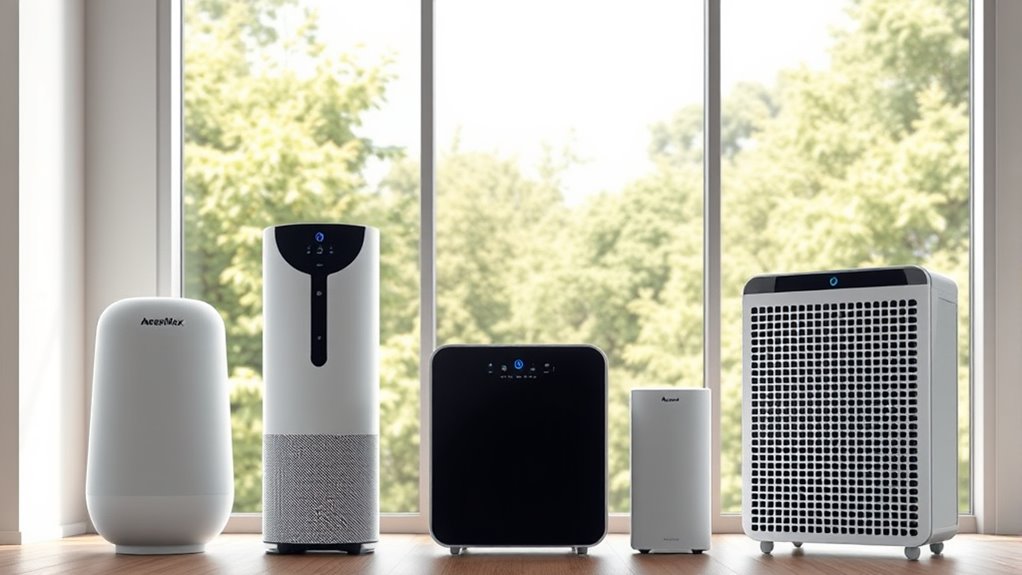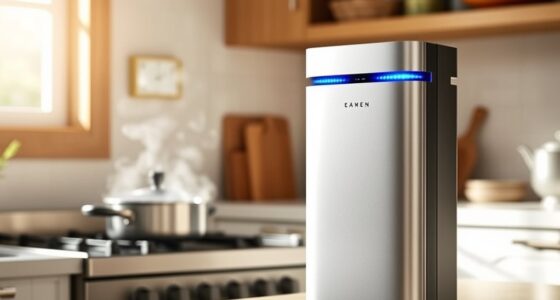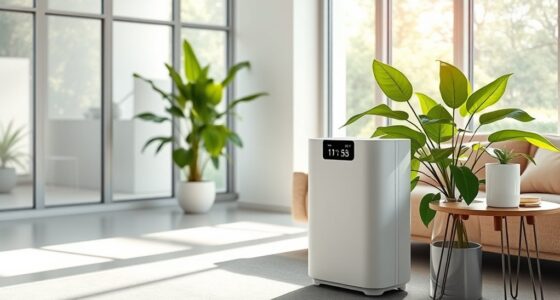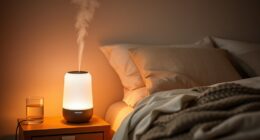Understanding AeraMax, BioGS, and other purifier technologies involves knowing how they use optimized airflow design and specialized filter materials. These systems draw in contaminated air efficiently, ensuring pollutants pass through multiple filters like HEPA and activated carbon, which trap tiny particles and odors. The synergy between airflow paths and high-quality filters maximizes purification, improves indoor air quality, and extends device life. Keep exploring to uncover how these innovations work together for cleaner, healthier air.
Key Takeaways
- AeraMax uses engineered airflow pathways combined with HEPA filters to maximize pollutant removal and indoor air quality.
- BioGS filters incorporate activated carbon and antimicrobial layers for odor control and bacteria elimination.
- Proper airflow design ensures even filter contact, reducing dead zones and improving purifier efficiency.
- Combining advanced filter materials with optimized airflow enhances removal of particles, bacteria, and VOCs.
- Selecting purifiers with quality filters and engineered airflow pathways ensures better performance and longer device lifespan.
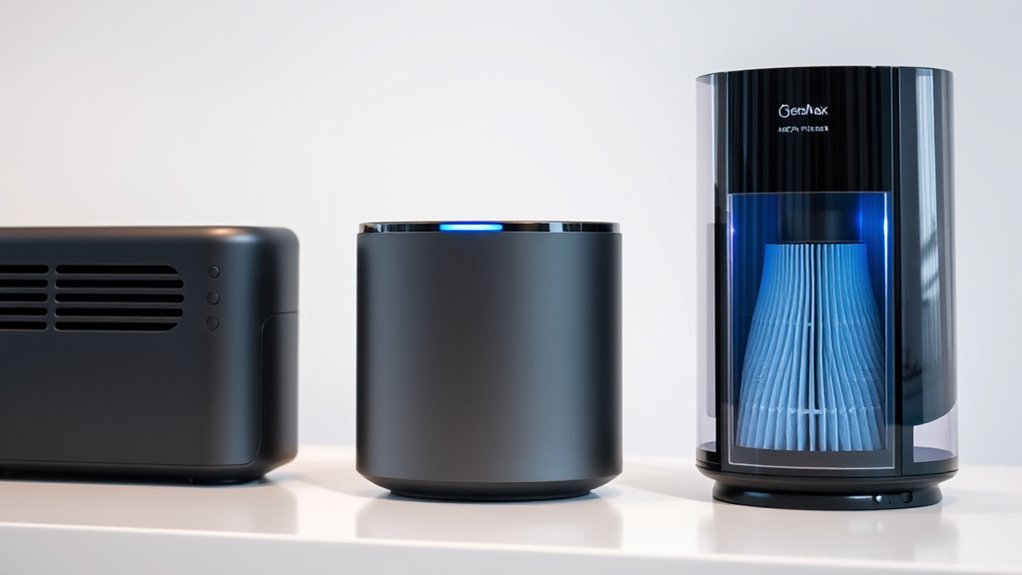
Have you ever wondered how modern purifier technologies keep the air and water clean and safe? The answer lies in the sophisticated design principles and advanced materials that make these systems effective. A critical aspect of these technologies is their airflow design, which determines how air moves through the purifier. Proper airflow ensures that contaminated air is drawn in efficiently, circulated past the filtering elements, and expelled as clean air. If the airflow isn’t optimized, particles and pollutants can bypass the filter or remain trapped in certain areas, reducing overall effectiveness. Many top-tier purifiers, like AeraMax, utilize carefully engineered airflow pathways that maximize contact between pollutants and filter media, ensuring thorough cleaning.
Filter materials play an equally vital role. These materials are the actual barriers that trap harmful particles, bacteria, and airborne contaminants. High-quality filter media are made from specialized fibers designed to capture particles as small as viruses and allergens. For example, AeraMax incorporates HEPA filters that use dense, pleated fibers to trap 99.97% of particles as tiny as 0.3 microns. BioGS filters, on the other hand, use a unique combination of activated carbon and antimicrobial layers to target odors, bacteria, and mold spores. The choice of filter material directly impacts the purifier’s ability to remove specific pollutants, making it essential for the device’s overall performance.
The design of airflow and the quality of filter materials work hand in hand. An crucial airflow design ensures that air passes swiftly and evenly through the filtering media, preventing dead zones where pollutants could linger. Meanwhile, advanced filter materials provide the physical or chemical barriers needed to remove contaminants effectively. This synergy allows purifiers to operate efficiently over extended periods, reducing maintenance frequency and improving indoor air quality. It’s also why many modern systems incorporate multiple filters—each targeting different types of pollutants—while maintaining a smooth, uninterrupted airflow.
Understanding these elements helps you appreciate how purifier technologies like AeraMax and BioGS deliver cleaner, healthier environments. They are engineered not just to trap dirt but to do so in a way that maximizes efficiency, longevity, and safety. When selecting a purifier, pay attention to the airflow design and filter materials, as these factors directly influence how well the device performs in your space. With the right combination, you can enjoy fresher air and safer water, free from the worries of airborne contaminants.
Additionally, the use of high-quality filters and optimized airflow pathways extends the lifespan of the purifier and maintains its effectiveness over time.
Frequently Asked Questions
How Do Aeramax and Biogs Compare in Allergen Removal Efficiency?
You want to know how Aeramax and BioGS compare in allergen removal efficiency. Both excel in air filtration effectiveness, but Aeramax often uses HEPA filters that trap tiny allergen particles more effectively. BioGS, with its biogenerating technology, can reduce allergens over time. While Aeramax provides immediate allergen particle removal, BioGS works gradually, making either suitable depending on your allergy needs.
Are These Purifiers Suitable for Large Industrial Spaces?
You might wonder if these purifiers suit large industrial spaces. While they excel in improving indoor air quality, their scalability can be limited for extensive areas. For ideal industrial air quality, you need systems specifically designed for large-scale purification. These units often require multiple devices or high-capacity models to effectively filter pollutants, ensuring cleaner air across the entire space. So, consider the purifier’s scalability before deploying it in industrial settings.
What Are the Maintenance Requirements for Each Purifier Type?
You need to know that maintenance varies among purifier types. Typically, you’ll replace filters regularly based on their filter lifespan, which can range from a few months to over a year. Check manufacturer guidelines for filter replacement intervals, and keep an eye on filter condition. Proper maintenance guarantees peak performance, so stay proactive with replacements and cleaning to keep your air purifier functioning effectively and efficiently.
Do These Technologies Eliminate Viruses and Bacteria Effectively?
Did you know that some air purifiers achieve up to 99.9% viral inactivation and bacterial filtration? These technologies are effective at reducing airborne viruses and bacteria, helping protect your indoor air quality. They use advanced filters and UV light to target and eliminate harmful pathogens. While no purifier guarantees complete sterilization, regular use considerably lowers your risk of airborne infections, making your space safer for you and your loved ones.
How Do Energy Consumption Levels Differ Among Purifier Technologies?
You might wonder how energy efficiency varies among purifier technologies. Generally, newer models focus on reducing power consumption, making them more energy-efficient. Some use advanced filters that require less energy to operate, while others might have higher power consumption due to more intensive cleaning cycles. By choosing a purifier with lower power consumption, you save on energy costs and reduce environmental impact, all without sacrificing air quality.
Conclusion
Now that you’ve explored Aeramax, Biogs, and other purifier technologies, you see how innovation meets necessity. These devices combat pollutants, protecting your health and environment. Yet, while their functions differ—some filter, others sterilize—they all share a common goal: cleaner air. It’s a dance of technology and nature, working together to create safer spaces. Ultimately, choosing the right purifier isn’t just about features; it’s about embracing a healthier, fresher future.
